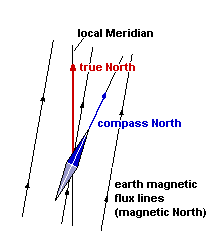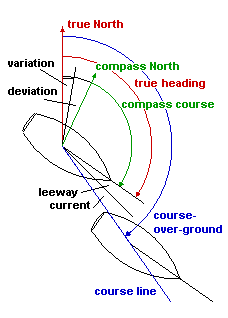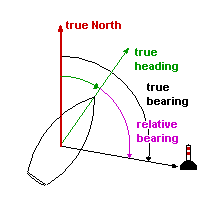Direction on Earth
In navigation, direction is expressed as the angular difference in degrees
from a reference direction, usually true North - for absolute direction - or the
ship's heading (keel line) - for relative direction.
The following navigational terms are related with directions as used in
maritime navigation.
North
While handling with a magnetic compass, the nautical navigator must distinguish
the following three different kind of North directions:
true North corresponds to the direction pointing towards the geographical
North Pole. This is equivalent with the "upward" direction of the local meridian.
magnetic North is the (horizontal) direction of the local magnetic flux lines.
This is not necessarily the direction of the magnetic north pole.
Even in moderate latitudes, the difference between the magnetic North direction and
true North may be up to 20 degrees.
compass North is the geographical direction the north side of the compass needle
points to. This is basically the same direction as magnetic North with some additional
component which depend on the magnetic environment of the compass.
|
 |
|
The difference between true North and magnetic North is called variation.
Variation is different for each location on the Earth and is mentioned on the
compass rose on each nautical chart.
The amount of variation slightly changes with time due to the slow
migration of the Earth's magnetic poles.
The annual change of variation is also recorded on the nautical chart.
|
|
The difference between magnetic North and compass North is called deviation.
Deviation is the magnetic influence of the immediate environment upon the compass.
It is usually caused by the steel or iron aggregates installed on the ship.
Especially on steel ships the deviation may be considerable.
The deviation also depends on the orientation of the ship within the
earth magnetic field. Practically, the compass deviation depends on the heading of the
ship. Therefore, a "Deviation Table" should be elaborated for each permanently installed
compass showing the compass deviation for different headings or courses
(0° through 360°).
|
Course
Course (C) is the horizontal direction in which a vessel is steered or
intended to be steered.
Depending on the reference direction the following terms are used:
true course or true heading is expressed as angular distance from
true North clockwise from 000° through 360°.
magnetic course refers to magnetic north.
compass course refers to the compass north direction, which is influenced
by variation and deviation.
In navigation only the "true heading" and "compass course" have a practical
meaning: true heading is the course used in the chart (when wind and current
course deviations are negligible) and compass course is the course the
helmsman will be steering while using the navigation compass.
Strictly used, course applies to the direction through the water. However
wind, sea and current may defer a vessel from it's intended course with
respect to the Earth.
Course-over-ground (COG) is the direction a vessel is travelling referring
to a fixed point (e.g. the surface of the Earth). A course line is drawn
in the chart extending from the current position in the direction of the
course-over-ground.
|
 |
The current course line may be used for dead reckoning navigation: logging
the travelled distance from the last determined position on the course line
will give the new position. Notice that when leeway (drift due to wind)
and current are not negligible, the course line will differ from "true
heading".
Track
Track is the intended (horizontal) direction of travel with respect to
the Earth. The track consists of one or a series of course lines, from
the point of departure to the destination, along which a journey is intended
to proceed.
Heading
Heading (Hdg) or keel line is the direction in which a vessel is pointed,
expressed as angular distance from 000° (North) clockwise through 360°.
Heading differs from course in that heading constantly changes as a
vessel yawls back and forth across the course due to sea, wind and steering
error. In this sense, course is the "mean" value of the constantly changing
heading.
Bearing
|
Bearing (B) is the direction of one terrestrial point
to another, expressed as angular distance from 000° (North) clockwise
through 360°.
Bearing and azimuth are sometimes used interchangeably, but azimuth
more accurately refers to the horizontal direction of a point on the celestial
sphere from a point on the Earth.
A relative bearing is measured relative to the ship's heading from 000°
(dead ahead) clockwise through 360°.
To convert a relative bearing to a true bearing, add the true heading:
true bearing = relative bearing + true heading
|
 |
|


